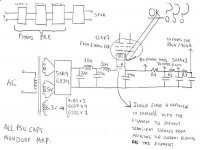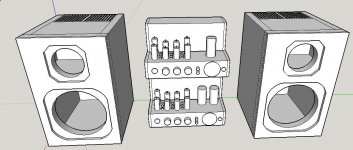Hi all. I'd first like to apologize for this tremendously lengthy post. It seems I am not good synthesizing ideas.
I was hoping someone more knowledgeable than me could help me figuring out if this is is a valid idea.
I am in the process of building an integrated, all tube amp which will consist of :
Now my problem is this. I've been able to use AC in the filaments in my previous projects but I am uncertain about the phono pre.
So my idea is to use AC in all the tubes but the 12ax7/6922 which is the first stage in the phono pre.
I have designed a tube based PSU which will output 12.6v 150mA (transformer => 5ar4 => CRC---RC => 12AX7 FILAMENT). I know I can just use solid state rectifiers etc but it's just that I really want this to be an "all tube" really design.
So, while reading and reading I found that there were some designs in the past that used the current in the cathodes of the output tubes (not el84 of course) to drive preamplifier filaments. Unfortunately 40x2mA (two el84 sharing the cathode resistor) is not enough to drive my 12ax7 BUT I figured out that I could connect the filaments of the 12ax7 in series with the B+ PSU (see attached image), just before the power amp, the current flowing through the PSU is around 150mA.
The thing is that I am not sure if this is a good idea. The PSU has to suply power for the transients and while I know much of that current is suplied by the end capacitors, when those capacitors discharge to suply the current for those peaks, there is a current increase in the PSU to fill them again, meaning that, for what I understand, the current in the PSU that would be flowing through the 12ax7 filaments is NOT constant.
To overcome this I got another idea which is to place a capacitor in paralell with the filament which is in series with the PSU (see attached image again), the idea being that all transients will be bypassed by this capacitor so the filament won't see those and will only see a stable current. Not sure if my thinking is correct here.
So my question is, do you think it this a good idea at all ? Of course I could build the PSU for the filaments but I consider that would be a "non-elegant" brute force solution. If I have the DC right there why not just use it ?
I have attached several images for the speakers, the amplifier as well, just to give you an idea of what is it I plan to build. I already have all the components and I am only missing the power transformer and chokes, wood for the cabinets and the bass speakers themselves and the arduino (TDA1541x2 are here too). All the rest has been bought and is waiting for me to put it all together meaning tubes, sockets, output transformers, 2xTDA1541, Fostex F120A, capacitors (all mundorf, even for the PSU), etc
Thank you so very much for reaching the end of this post and for any help or idea or thought you can provide.
I was hoping someone more knowledgeable than me could help me figuring out if this is is a valid idea.
I am in the process of building an integrated, all tube amp which will consist of :
- A 12ax7 - RIAA - 6922 phono pre as described here (see attached image), designed by ThorstenL and explained here (http://www.diyaudio.com/forums/tubes-valves/28957-dc-phono.html)
- A 6cg7 direct connected to another 6cg7 which I will use to amplify the signal coming from a DIY TDA1451 DAC (Raspberri PI => 12ax7)
- A 6cg7 driving a single ended triode EL84 which will be connected to a fostex f120a closed speaker which will reproduce from 120hz and up.
- A 6cg7 tube cathode follower which I will use to send some signal to a bass amplifier driving an active sealed DIY equalized woofer (not subwoofer) 30hz to 120hz aprox.
Now my problem is this. I've been able to use AC in the filaments in my previous projects but I am uncertain about the phono pre.
So my idea is to use AC in all the tubes but the 12ax7/6922 which is the first stage in the phono pre.
I have designed a tube based PSU which will output 12.6v 150mA (transformer => 5ar4 => CRC---RC => 12AX7 FILAMENT). I know I can just use solid state rectifiers etc but it's just that I really want this to be an "all tube" really design.
So, while reading and reading I found that there were some designs in the past that used the current in the cathodes of the output tubes (not el84 of course) to drive preamplifier filaments. Unfortunately 40x2mA (two el84 sharing the cathode resistor) is not enough to drive my 12ax7 BUT I figured out that I could connect the filaments of the 12ax7 in series with the B+ PSU (see attached image), just before the power amp, the current flowing through the PSU is around 150mA.
The thing is that I am not sure if this is a good idea. The PSU has to suply power for the transients and while I know much of that current is suplied by the end capacitors, when those capacitors discharge to suply the current for those peaks, there is a current increase in the PSU to fill them again, meaning that, for what I understand, the current in the PSU that would be flowing through the 12ax7 filaments is NOT constant.
To overcome this I got another idea which is to place a capacitor in paralell with the filament which is in series with the PSU (see attached image again), the idea being that all transients will be bypassed by this capacitor so the filament won't see those and will only see a stable current. Not sure if my thinking is correct here.
So my question is, do you think it this a good idea at all ? Of course I could build the PSU for the filaments but I consider that would be a "non-elegant" brute force solution. If I have the DC right there why not just use it ?
I have attached several images for the speakers, the amplifier as well, just to give you an idea of what is it I plan to build. I already have all the components and I am only missing the power transformer and chokes, wood for the cabinets and the bass speakers themselves and the arduino (TDA1541x2 are here too). All the rest has been bought and is waiting for me to put it all together meaning tubes, sockets, output transformers, 2xTDA1541, Fostex F120A, capacitors (all mundorf, even for the PSU), etc
Thank you so very much for reaching the end of this post and for any help or idea or thought you can provide.
Attachments
1 - what happens at switch on when power supply caps are charging?
2 - 200v max heater to cathode voltage for 12ax7.
Just use SS rectifier supply. Heaters will be hot before tube rectified B+ appears.
2 - 200v max heater to cathode voltage for 12ax7.
Just use SS rectifier supply. Heaters will be hot before tube rectified B+ appears.
Worst idea I have seen in years. The tubes will not live long and the signal will modulate on the filament ! Max. heater to cathode voltage will indeed be exceeded too.
Use Schottky diodes, CLC filtering if you prefer or just a large buffer cap and a recent ultra low drop LDO and feed all tubes 6.3V DC. If you can hear difference between tube rectifier and diodes for filament power you really need professional assistance 🙂 Solid state has much better properties for glowing a resistor (a filament is like a light bulb). Less excess heat from useless dissipation, lower impedance, lower creep in voltage, lower ripple voltage, lower price, lower anything except for quality. Keep an eye on slow turn on (if possible technically, depends on the regulator you use), your tubes will live longer with lower power on current in cold state.
B+ is a different story though.
Use Schottky diodes, CLC filtering if you prefer or just a large buffer cap and a recent ultra low drop LDO and feed all tubes 6.3V DC. If you can hear difference between tube rectifier and diodes for filament power you really need professional assistance 🙂 Solid state has much better properties for glowing a resistor (a filament is like a light bulb). Less excess heat from useless dissipation, lower impedance, lower creep in voltage, lower ripple voltage, lower price, lower anything except for quality. Keep an eye on slow turn on (if possible technically, depends on the regulator you use), your tubes will live longer with lower power on current in cold state.
B+ is a different story though.
Last edited:
- Status
- Not open for further replies.


